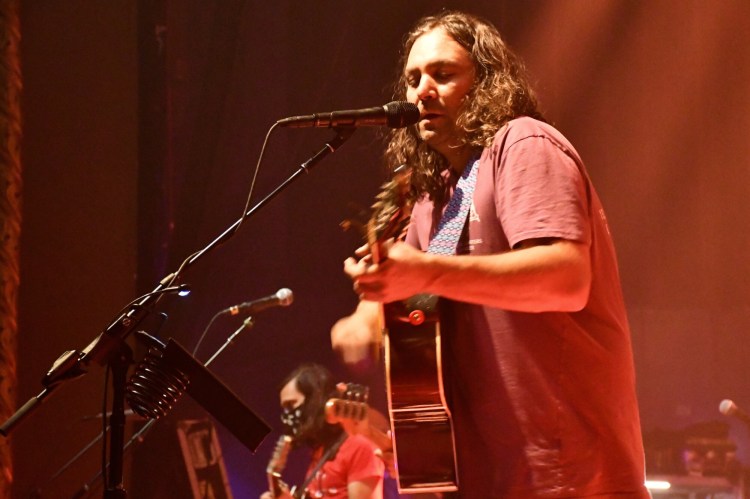
Singer and lead guitarist Adam Granduciel of The War on Drugs at the State Theatre on Monday. Photo by Robert Ker
Philadelphia rock band The War on Drugs returned to the State Theatre on Monday for the first time since 2017 – and what could be the last time before they move on to Thompson’s Point or other larger venues.
The attendance was impressive for a Monday show, and the crowd was rewarded with a band that acted as if they’ve been playing bigger stages for a long time now. Applying the ethos of dressing for the job you want, not the job you have, The War on Drugs offer arena rock no matter where they find themselves. Arenas may or may not regularly be in their future (they did play Madison Square Garden earlier this year), but they are capable of making rooms like the State feel like one.
They accomplish this by adopting the grandiose gestures of arena or heartland rock of past years, specifically the 1980s, offering songs for people who are running against the wind after the boys of summer are gone, and still haven’t found what they’re looking for. They wield nostalgia as their greatest tool, not only using the sweeping rock sounds of past eras to summon longing for an ephemeral moment, but also constant lyrical cues.
The notion of the past featured early in the set, in songs such as “Holding On” and “Pain,” but the band treats time like something that flows around you and either sweeps you away or causes you to get stuck. The driving nature of the songs makes them feel like they are in transit themselves, evoking landscapes through a car window.
As with most other bands, the pandemic halted The War on Drugs’ own forward momentum and drastically cut into their income; they have spent 2022 making up for lost time, playing 90 concerts and leaning heavily on material from their wonderful 2021 album “I Don’t Live Here Anymore.” These songs are a year old but didn’t exist the last time the band toured here and proved strong in the live setting.
“Harmonia’s Dream” was one of the evening’s high points; it opened with an extended passage of electronic music before erupting into the song. The glittery “I Don’t Wanna Wait” would have surely scored a prom scene in a movie if it had been released decades earlier. Indeed, the band is single-handedly keeping the power ballad alive, performing lighter-raising songs for an era in which hardly anybody carries lighters.
This is not to say The War on Drugs trades strictly in nostalgia. The band nods to the aesthetics of Springsteen and Seger, but they also rearrange those sounds for a modern context, emphasizing the low end while adding luxurious layers of instrumentation and nimble guitar solos. At times they can sound like a DJ at a dance party, toying with tension and release and then bumping up the best parts of their songs to keep the audience moving.
Nowhere was the effectiveness of that approach more apparent than with the two outsized anthems that towered above the rest: “Under the Pressure” and “I Don’t Live Here Anymore.” The band played both near the end of the set, and milked the former song in particular, stretching it out on both sides of the song proper, and tossing a saxophone-driven crescendo in the middle, inspiring what was easily the most enthusiastic crowd reaction of the night. This ability to send people home happy is a large part of what has enabled The War on Drugs’ growth.
Robert Ker is a freelance writer in Portland. He can be reached at bobzker@gmail.com.
Send questions/comments to the editors.



Comments are no longer available on this story